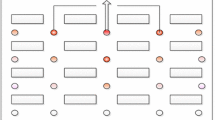Abstract
In fires, people are easier to lose their mind. Panic will lead to irrational behavior and irreparable tragedy. It has great practical significance to make contingency plans for crowd evacuation in fires. However, existing studies about crowd simulation always paid much attention on the crowd density, but little attention on emotional contagion that may cause a panic. Based on settings about information space and information sharing, this paper proposes an emotional contagion model for crowd in panic situations. With the proposed model, a behavior mechanism is constructed for agents in the crowd and a prototype of system is developed for crowd simulation. Experiments are carried out to verify the proposed model. The results showed that the spread of panic not only related to the crowd density and the individual comfort level, but also related to people’s prior knowledge of fire evacuation. The model provides a new way for safety education and evacuation management. It is possible to avoid and reduce unsafe factors in the crowd with the lowest cost.

















Similar content being viewed by others
References
Banarjee, S., Grosan, C., & Abraham, A. (2005). Emotional ant based modeling of crowd dynamics. In 7th International Symposium on Symbolic and Numeric Algorithms for Scientific Computing. ITimisoara, pp. 279–286.
Bouvier, E., & Cohen, E. (1995). Simulation of human flow with particle systems. Proceedings of the Simulators International, 12, 349–354.
Corradi, O., Hjorth, P. G., & Starke, J. (2012). Equation-free detection and continuation of a Hopf bifurcation point in a particle model of pedestrian flow. The SIAM Journal on Applied Dynamical Systems, 11(3), 1007–1032.
Curtis, S., Zafar, B., Gutub, D., et al. (2013). Asymmetric agent interactions in crowds. Visual Computer, 29, 1277–1292.
Daamen, W. (2004). Modelling passenger flows in public transport facilities. Delft: Delft University of Technology.
Egges, A., Kshirsagar, S., & Thalmann, N. M. (2004). Generic personality and emotion simulation for conver-sational agents. Computer Animation and Virtual Worlds, 15(1), 1–13.
Galland, S., Gaud, N., Demange, J., et al. (2014). Multilevel model of the 3D virtual environment for crowd simulation in buildings. Procedia Computer Science, 32, 822–827.
Gu, Z., Liu, Z., Shiwakoti, N., et al. (2016). Video-based analysis of school students’ emergency evacuation behavior in earthquakes. International Journal of Disaster Risk Reduction, 18, 1–11.
Hatfield, E., Cacioppo, J. T., & Rapson, R. L. (1994). Emotion contagion. UK: Cambridge University Press.
Helbing, D., Farkas, I., & Vicsek, T. (2000). Simulating dynamical feature of escape panic. Nature, 407(6803), 487–490.
Huang, P., & Liu, Z. (2012). A model of crowd emotion behavior in a theater fire escaping. Bulletin of science and technology, 28(7), 71–74.
Hughes, R. L. (2000). The flow of large crowds of pedestrians. Mathematics and Computers in Simulation, 53(4–6), 367–370.
Jed, M. E., Pallamin, N., Dugdale, J., et al. (2004). Modelling character emotion in an interactive virtual environment. In AISB 2004 convention, symposium on language, speech and gesture for expressive characters (pp. 20–29). Leeds, UK.
Kim, K., & Kim, K. J. (2010). Multi-agent-based simulation system for construction operations with congested flows. Automation in Construction, 19(7), 867–874.
Liu, Z., Wei, J., Huang, P., et al. (2013). An emotion contagion simulation model. Journal of Computer Research and Development, 50(12), 2578–2589.
Luo, L., Zhou, S., Cai, W., et al. (2008). Agent-based human behavior modeling for crowd simulation. Computer Animation Virtual Worlds, 19(3–4), 271–281.
Niederberger, C., & Gross, M. (2003). Hierarchical and heterogeneous reactive agents for real-time applications. Computer Graphics Forum, 22(3), 323–331.
Oguz, O., Akaydın, A., Yilmaz, T., et al. (2010). Emergency crowd simulation for outdoor environments. Computational Graphics, 34(2), 136–144.
Ondrej, J., Pettre, J., Olivier, A., et al. (2010). A synthetic-vision based steering approach for crowd simulation. In ACM Transactions on graphics. Los Angeles.
Ortony, A., Clore, G. L., & Collins, A. (1998). The cognitive structure of emotions. Cambridge: Cambridge University Press.
Parisi, D. R., & Dorso, C. O. (2007). Morphological and dynamical aspects of the room evacuation process. Physica A, 385(1), 343–355.
Picard, R. W. (1997). Affective computing. Cambridge: MIT Press.
Qiu, F., & Hu, X. (2010). Modeling group structures in pedestrian crowd simulation. Simulation Modelling Practice and Theory, 18(2), 190–205.
Sakuma, T., Mukai, T., & Kuriyama, S. (2005). Psychological model for animating crowded pedestrians. Computer Animation and Virtual Words, 16, 343–351.
Seyfried, A., Steffen, B., & Lippert, T. (2006). Basics of modelling the pedestrian flow. Physica A, 368(1), 232–238.
Song, Z. C., Ge, Y. Z., Duan, H., et al. (2016). Agent-based simulation systems for emergency management. International Journal of Automation and Computing, 13(2), 89–98.
Treuille, A., Cooper, S., & Popovic, Z. (2006). Continuum crowds. ACM Transactions on Graphics, 25(3), 1160–1168.
Van, B. J. D., Lin, M., & Manocha, D. (2008). Reciprocal velocity obstacles for real-time multi-agent navigation. Proceedings—IEEE International Conference on Robotics and Automation, 2008, 1928–1935.
Xiong, M., Lees, M., Cai, W., et al. (2010). Analysis of an efficient rule-based motion planning system for simulating human crowds. Visual Computer, 26, 367–383.
Zhou, S., Chen, D., Cai, W., et al. (2010). Crowd modeling and simulation technologies. ACM Transactions on Modeling and Computer Simulation, 20(4), 1–39.
Acknowledgement
This work was partially supported by the National Natural Science Foundation of China (Grant No. 61373068, U1636111), National Natural Science Foundation of Zhejiang (Grant No. LQ17F020001), Ningbo science and technology plan projects (Grant Nos. 2015A610128, 2016D10016, 2015D10011), and National Natural Science Foundation of Shanghai (Grant No. 15ZR1417200), Ningbo University Research Project (xkxl1529).
Author information
Authors and Affiliations
Corresponding author
Rights and permissions
About this article
Cite this article
Liu, T.T., Liu, Z., Ma, M. et al. An Information Perception-Based Emotion Contagion Model for Fire Evacuation. 3D Res 8, 10 (2017). https://doi.org/10.1007/s13319-017-0120-4
Received:
Revised:
Accepted:
Published:
DOI: https://doi.org/10.1007/s13319-017-0120-4




